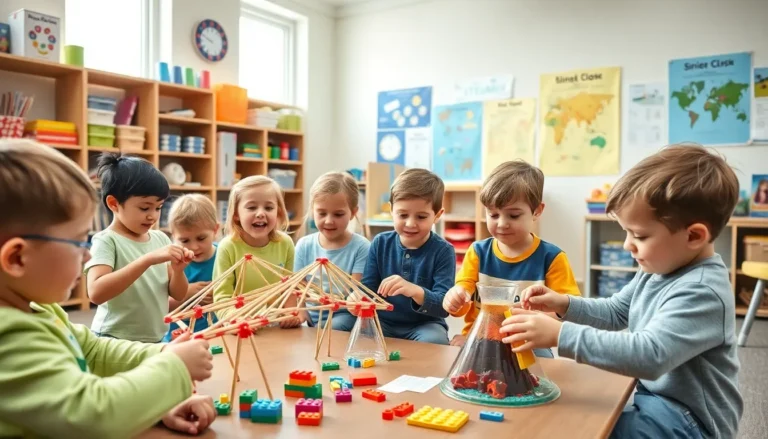Table of Contents
ToggleFostering isn’t just a cozy term for giving someone a warm hug. It’s about stepping up to provide care and support, often to those who need it most. Imagine being a superhero without a cape, swooping in to make a difference in someone’s life. That’s the essence of fostering.
When people think of fostering, they often picture cute kids or fluffy puppies, but it goes way beyond that. It’s about creating a safe space where individuals can thrive, learn, and grow. Whether it’s nurturing a child or providing a temporary home for a pet, fostering is all about love, compassion, and a sprinkle of patience. So, let’s dive into what fostering really means and why it’s an incredible journey worth exploring.
Overview of Fostering
Fostering represents a critical commitment to supporting individuals in challenging situations. It involves providing a nurturing space where children or animals can experience love and stability. Fostering goes beyond mere care; it creates opportunities for personal growth and emotional healing.
Safe and supportive environments often become the foundation for any fostering relationship. Parents or guardians who foster enable children to experience constructive relationships. Animals in foster care often receive the attention they need to recover and thrive. Through patience and understanding, foster parents help individuals build trust and self-esteem.
Community involvement plays a vital role in fostering. Individuals who choose to foster often collaborate with organizations to ensure proper training and resources. Access to resources helps foster parents navigate the complexities of caregiving. Support systems offer guidance and encouragement throughout the journey.
Rewards from fostering extend to both the caregivers and those they support. Caring for a child or animal often brings a sense of fulfillment and achievement. Positive experiences contribute to the emotional and mental well-being of foster caregivers. Lasting bonds form through shared moments of joy and growth.
Fostering fulfills a significant need within society. It provides essential support to vulnerable demographics. By prioritizing loving care, fostering allows for second chances and new beginnings.
Definition of Fostering
Fostering represents a critical act of caring for individuals needing support, reflecting a profound commitment to create safe and nurturing environments.
Historical Context
Fostering has deep historical roots. Ancient civilizations often viewed fostering as a communal responsibility. Many cultures traditionally cared for orphaned children and injured animals, signaling a societal obligation to support the vulnerable. During the 20th century, fostering evolved into formal systems designed to address orphans and abandoned children. Legislative changes shaped fostering practices, ensuring better protection for those involved. As society expanded its understanding of vulnerable populations, the practice increasingly embraced diverse relationships, including fostering for pets and special needs individuals. This historical backdrop emphasizes the significant evolution and constant adaptation of fostering to meet ongoing societal needs.
Contemporary Understanding
Contemporary understanding of fostering encompasses various aspects of caregiving. Today’s foster care system aims to provide temporary homes for children and animals facing neglect or abandonment. Many stakeholders recognize fostering’s vital role in individual development, enabling growth and healing. Foster parents undertake critical responsibilities, creating stable environments crucial for trust-building and emotional well-being. Mental health professionals, educators, and child welfare organizations increasingly support foster caregivers to enhance their effectiveness. These collaborations amplify resources and training available to foster homes. Modern fostering extends beyond traditional roles, including support for youth aging out of care and fostering animals awaiting adoption, emphasizing its ongoing relevance in nurturing vulnerable populations.
Types of Fostering
Fostering takes many forms, each tailored to meet specific needs. Understanding these types highlights how diverse fostering can be.
Family-Based Fostering
Family-based fostering provides a home for children in need, emphasizing stability and parental support. In this setup, caregivers offer a familial environment, aiming to replicate a typical home life. Guidance, nurturing, and love play pivotal roles in helping children adapt. Support from biological parents often continues, facilitating smoother transitions and connections. Family-based fostering promotes emotional safety, allowing children to develop trust and security within their new environment. This type increases the likelihood of positive outcomes, as stable family dynamics foster healthy attachments.
Therapeutic Fostering
Therapeutic fostering addresses the needs of children with emotional and behavioral challenges. In these arrangements, specially trained foster parents create tailored support systems. Therapeutic foster care incorporates professional interventions, such as counseling and behavioral strategies. Caregivers receive training to manage complex situations, ensuring children receive consistent support. This fostering type focuses on emotional healing, often leading to improved behavioral outcomes. Collaborations with mental health professionals enhance the effectiveness of therapeutic fostering. Dedicated support structures empower children to develop coping skills and resilience in supportive environments.
Benefits of Fostering
Fostering offers numerous benefits for both individuals in need and the families that provide care. This section outlines how fostering impacts specific groups.
For Foster Children
Foster children experience significant advantages from supportive environments. They gain access to stable housing, which fosters trust and security. Foster care provides educational opportunities, encouraging academic growth and socialization. Emotional support from foster parents empowers children to express their feelings openly. Some foster children develop essential life skills through the guidance offered in these nurturing settings. They often build resilience, overcoming past traumas with the help of compassionate caregivers. Relationships formed during foster care can lead to improved self-esteem, as children receive consistent encouragement. Ultimately, fostering can transform lives and facilitate healing.
For Foster Families
Foster families also encounter numerous rewards while supporting vulnerable individuals. They cultivate a sense of purpose from helping children or animals in need. Emotional connections often develop, enriching the family dynamic as caregivers bond with those they support. Foster families receive various training resources, enhancing their caregiving skills. Many foster parents report increased empathy and understanding through their experiences, positively influencing their outlook on life. Engaging in fostering activities fosters community connections and builds lasting friendships with fellow caregivers. Additionally, fostering can open doors to personal growth and self-discovery, providing unique perspectives on life’s challenges.
Challenges in Fostering
Fostering presents various challenges that require commitment and understanding from caregivers. Emotional and psychological aspects often significantly impact both foster children and parents.
Emotional and Psychological Aspects
Foster children frequently experience trauma from their past, leading to emotional instability. Trust issues arise, making it difficult for them to form lasting relationships. Caregivers encounter frustration as they navigate these complexities. Supporting a child’s emotional healing involves patience and empathy with each child’s individual needs. Ongoing professional support, such as therapy, serves as a vital resource for both children and caregivers. Equipments that foster caregivers with strategies to manage emotional responses foster better outcomes for all involved.
Practical Considerations
Practical challenges also arise in fostering situations. Financial constraints often burden foster families, as they must provide for children’s needs on a limited budget. Time management becomes crucial when balancing work and caregiving responsibilities. Navigating the foster care system requires knowledge of legal processes and on occasion, frequent visits from social workers. Training programs offered by agencies enhance caregivers’ skills and effectiveness in meeting children’s needs. Community resources play an essential role, providing foster families with helpful tools and information necessary for success.
Conclusion
Fostering embodies a profound commitment to nurturing those in need. It creates safe havens where individuals can rebuild their lives and develop essential skills. The journey of fostering not only transforms the lives of children and animals but also enriches the caregivers’ experiences.
Through patience and understanding, foster parents play a critical role in fostering emotional healing and personal growth. Despite the challenges that come with this responsibility, the rewards are immense. Fostering opens doors to new possibilities and fosters a sense of community that benefits everyone involved. Embracing this journey can lead to lasting change and a brighter future for all.







